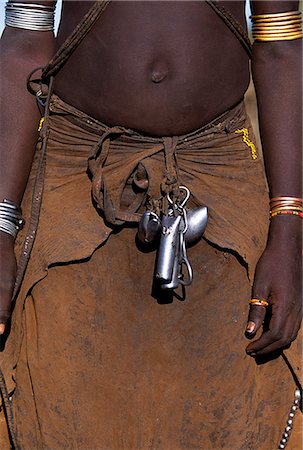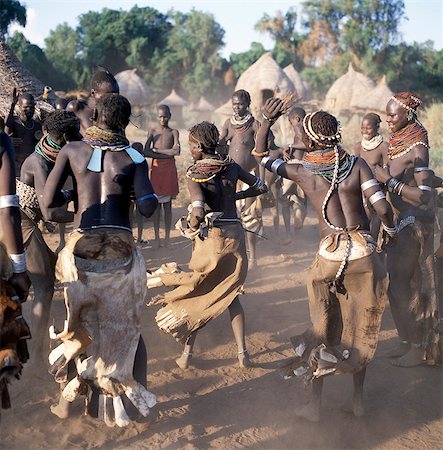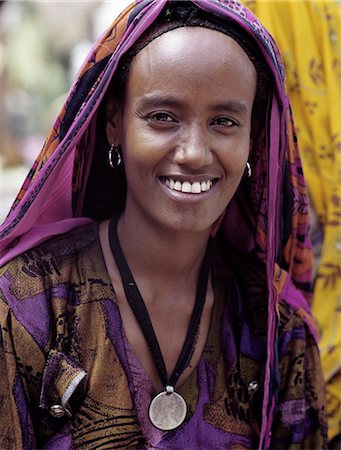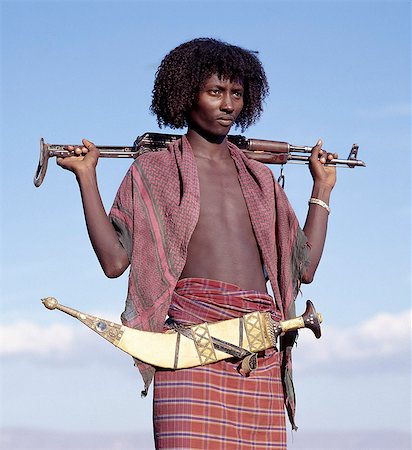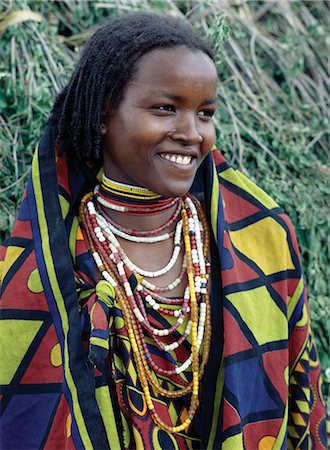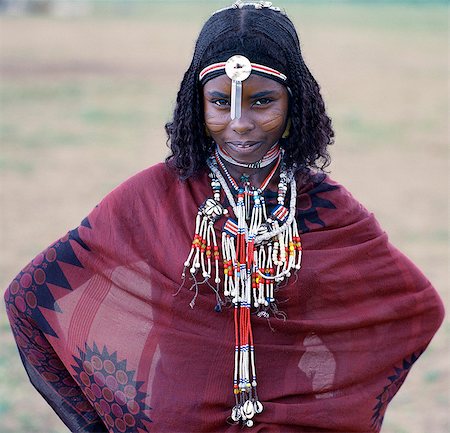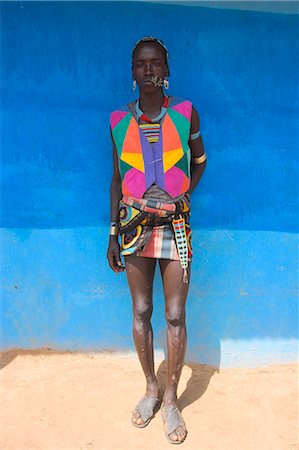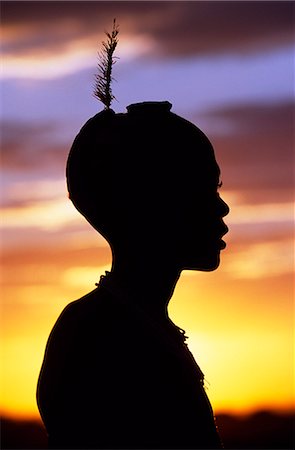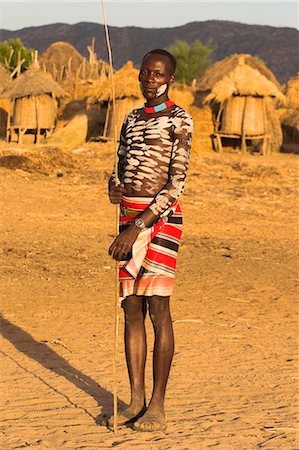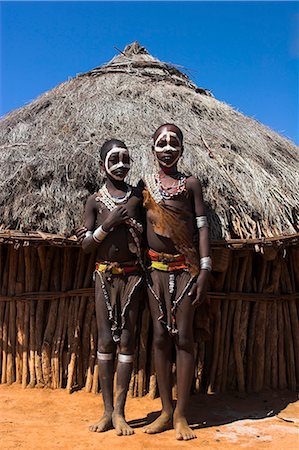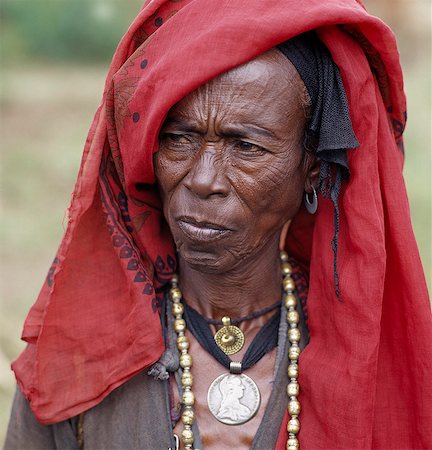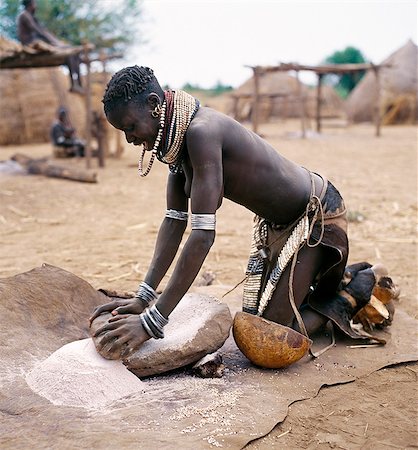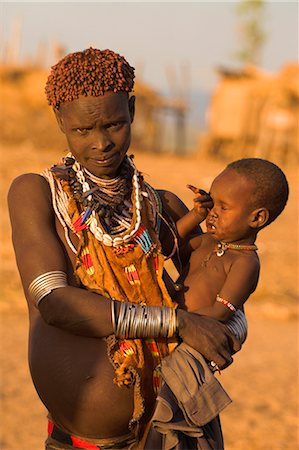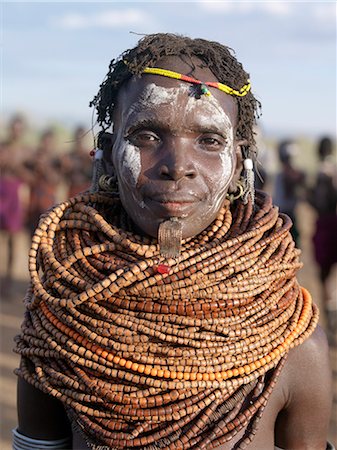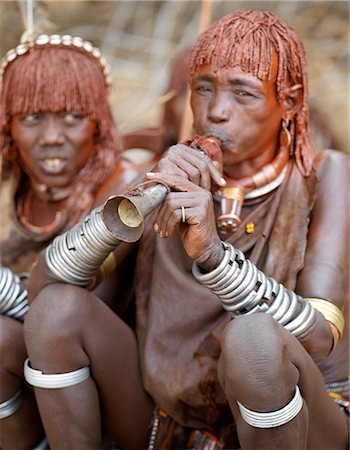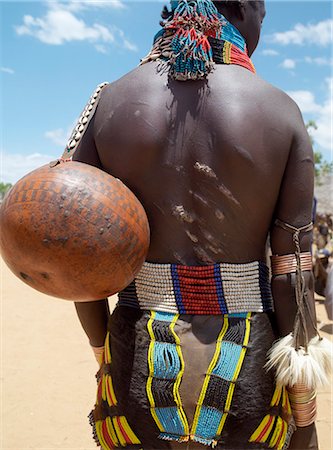-
A Dassanech girl braids her sister's hair at her village in the Omo Delta. Much the largest of the tribes in the Omo Valley numbering around 50,000,the Dassanech (also known as the Galeb,Changila or Merille) and Nilotic pastoralists and agriculturalists.
Rights-Managed
-
A Dassanech woman winnows grain by pouring it from her metal tin and letting it fall onto a calfskin. Much the largest of the tribes in the Omo Valley numbering around 50,000,the Dassanech (also known as the Galeb,Changila or Merille) and Nilotic pastoralists and agriculturalists.
Rights-Managed
-
A young Dassanech girl wears a leather skirt,metal bracelets and amulets and layers of bead necklaces. Much the largest of the tribes in the Omo Valley numbering around 50,000,the Dassanech (also known as the Galeb,Changila or Merille) are Nilotic pastoralists and agriculturalists.
Rights-Managed
-
A Karo women stands in the doorway to her hut in the village of Duss. A small Omotic tribe related to the Hamar, who live along the banks of the Omo River in southwestern Ethiopia, the Karo are renowned for their elaborate body painting using white chalk, crushed rock and other natural pigments. In addition to painting her face she has decorated her body with whorls of goat hair tied by leather co
Rights-Managed
-
Two young Dassanech boys sport elaborate clay hairdos at their settlement alongside the Omo River. Much the largest of the tribes in the Omo Valley numbering around 50,000,the Dassanech (also known as the Galeb,Changila or Merille) are Nilotic pastoralists and agriculturalists.
Rights-Managed
-
Warriors of the nomadic Afar tribe wear their hair long and carry large curved daggers, known as jile, strapped to their waists.Proud and fiercely independent, they live in the low lying deserts of Eastern Ethiopia.Modern rifles have now replaced daggers as weapons although most young men still wear ornate daggers by tradition.
Rights-Managed
-
A Nyangatom woman dries sorghum and other corn in the vicinity of her elevated grain stores, which prevent loss when the Omo River bursts its banks.The Nyangatom are one of the largest tribes and arguably the most warlike people living along the Omo River in Southwest Ethiopia.
Rights-Managed
-
A young Dassanech girl wears a leather skirt,metal bracelets and amulets and layers of bead necklaces. A long leather strap decorated with cowrie shells hangs down her back. Much the largest of the tribes in the Omo Valley numbering around 50,000,the Dassanech (also known as the Galeb,Changila or Merille) are Nilotic pastoralists and agriculturalists.
Rights-Managed
-
A young Dassanech girl holds her little brother. She wears a leather skirt with an elaborate fringe of wooden and metal tassles. Much the largest of the tribes in the Omo Valley numbering around 50,000,the Dassanech (also known as the Galeb,Changila or Merille) are Nilotic pastoralists and agriculturalists.
Rights-Managed
-
A Nyangatom woman wearing an elegant skirt with a short beaded fringe at the font and long calfskin tail reaching the ground at the back. This woman has a broad belt decorated with cowrie shells. The Nyangatom or Bume are a Nilotic tribe of semi-nomadic pastoralists who live along the banks of the Omo River in south-western Ethiopia.
Rights-Managed
-
A young Nyangatom woman carries her baby on her hip in an elaborately braided papoose. Her hair has been reddened with a mixture of ochre and animal fat. Typical of her tribe, she wears a calfskin skirt, multiple layers of bead necklaces and metal bracelets and amulets. The Nyangatom or Bume are a Nilotic tribe of semi nomadic pastoralists who live along the banks of the Omo River in south western
Rights-Managed
-
A young Dassanech girl holds her little brother. She wears a leather skirt with an elaborate fringe of wooden and metal tassles. Much the largest of the tribes in the Omo Valley numbering around 50,000,the Dassanech (also known as the Galeb,Changila or Merille) are Nilotic pastoralists and agriculturalists.
Rights-Managed
-
A tourist accompanied by a retinue of children in a Dassanech settlement along the lower Omo River. Much the largest of the tribes in the Omo Valley numbering around 50,000,the Dassanech (also known as the Galeb,Changila or Merille) and Nilotic pastoralists and agriculturalists.
Rights-Managed
-
A Nyangatom mother and young daughter in typical dress. Rugged skin clothing is still widely used.The Nyangatom are one of the largest tribes and arguably the most warlike people living along the Omo River in Southwest Ethiopia.
Rights-Managed
-
A lively Nyangatom dance is enjoyed by villagers in the late afternoon.The elevated houses in the background are both homes and granaries, which have been built to withstand flooding when the Omo River bursts its banks The Nyangatom are one of the largest tribes and arguably the most warlike people living along the Omo River in Southwest Ethiopia.
Rights-Managed
-
A Nyangatom woman stands with her baby on her hip beside her grass hut in his temporary camp. Nyangatom married women wear elaborately beaded skirts which reach the ground at the back and often have panels of different coloured calkfskin sewn into the tail The Nyangatom or Bume are a Nilotic tribe of semi nomadic pastoralists who live along the banks of the Omo River in south western Ethiopia.
Rights-Managed
-
A woman in a colourful dress and matching headscarf wears round her neck a Maria Theresa thaler an old silver coin minted in Austria, which was widely used as currency in northern Ethiopia and Arabia until the end of World War II.
Rights-Managed
-
A Nyangatom warrior has painted his body and face in preparation for a dance. Most adult males carry rifles both as status symbols and in case of cattle raids or disputes with neighbouring tribes. The Nyangatom or Bume are a Nilotic tribe of semi-nomadic pastoralists who live along the banks of the Omo River in south-western Ethiopia.
Rights-Managed
-
Warriors of the nomadic Afar tribe wear their hair long and carry large curved daggers, known as jile, strapped to their waists.Proud and fiercely independent, they live in the low lying deserts of Eastern Ethiopia.Modern rifles have now replaced daggers as weapons although most young men still wear ornate daggers by tradition.
Rights-Managed
-
A pretty Borana girl at Mega in southern Ethiopia wears brightly coloured cotton cloth and numerous strings of beads. The pastoral Borana live either side of the southern Ethiopian/northern Kenya border and form a large and important group of the Oromo-speaking cluster of tribes.
Rights-Managed
-
Warriors of the nomadic Afar tribe carry large curved daggers, known as jile, strapped to their waists.Proud and fiercely independent, they live in the low lying deserts of Eastern Ethiopia.
Rights-Managed
-
Ethiopia, Amhara Region, Lasta, Lalibela. At sunrise worshippers attend an early morning outside service at the famous ancient rock-hewn Church of Saint George.
Rights-Managed
-
Ethiopia, Amhara Region, Lasta, Lalibela. At sunrise, worshippers attend an early morning outside service at the famous ancient rock-hewn Church of Saint George.
Rights-Managed
-
An old Borana man at Chew Bet in southern Ethiopia. His unbleached cotton wrap and turban are typical of the older generation of his tribe.The pastoral Borana live either side of the southern Ethiopian/northern Kenya border and form a large and important group of the Oromo-speaking cluster of tribes.
Rights-Managed
-
Karo people with body painting, made from mixing animal pigments with clay, dancing, Kolcho village, Lower Omo valley, Ethiopia, Africa
Rights-Managed
-
A Karo woman with her face painted in preparation for a dance in the village of Duss. A small Omotic tribe related to the Hamar, who live along the banks of the Omo River in southwestern Ethiopia, the Karo are renowned for their elaborate body painting using white chalk, crushed rock and other natural pigments. She is wearing a goatskin apron and carries a leather belt decorated with cowrie shells
Rights-Managed
-
Hamer lady wearing traditional goat skin dress decorated with cowie shells, carrying kalash on her way to market, Dombo village, Turmi, Lower Omo valley, Ethiopia, Africa
Rights-Managed
-
An attractive girl from the Kediyo tribe carries a large,beautifully made umbrella. Its wooden frame is covered with the dried leaves of ensete,the false banana plant (seen growing in the background). Widely cultivated in southern Ethiopia,ensete roots and stems,which are rich in carbohydrates,are either cooked and eaten as a porridge or made into bread.
Rights-Managed
-
An Afar girl with braided hair has very noticeable scarification on her cheeks. Scarification is practiced in only a few sections of her tribe. Proud and fiercely independent,the nomadic Afar people live in the low-lying deserts of Eastern Ethiopia.
Rights-Managed
-
A young Ethiopian girl with unusual braided hair; the crown of her head has been smeared with a greenish substance. Her two pendants are made from Maria Theresa thalers old silver coins minted in Austria,which were widely used as currency in northern Ethiopia and Arabia until the end of World War II.
Rights-Managed
-
Tsemay man in colourful clothing at weekly market, Key Afir, Lower Omo Valley, Ethiopia, Africa
Rights-Managed
-
Women sing and dance before the bull jumping, Hamer Jumping of the Bulls initiation ceremony, Turmi, Lower Omo valley, Ethiopia, Africa
Rights-Managed
-
The fetching hairstyle of a young Afar girl. Proud and fiercely independent,the nomadic Afar people live in the low-lying deserts of Eastern Ethiopia.
Rights-Managed
-
A Karo woman wears an elaborate headdress made from the wing-cases of beetles and a cape of calf skin fringed with cowrie shells. A small Omotic tribe related to the Hamar,who live along the banks of the Omo River in southwestern Ethiopia,the Karo are renowned for their elaborate body painting using white chalk,crushed rock and other natural pigments.
Rights-Managed
-
A young Afar girl at Filwoha in the Awash National Park. Filwoha in the Afar language means 'hot water'. The beautiful springs are surrounded by doum palms and rise from deep underground at about 96.8 degrees F.
Rights-Managed
-
An Afar girl has her attractive hairstyle embellished with buttons and beads,which is typical of the young girls of her tribe. Proud and fiercely independent,the nomadic Afar people live in the low-lying deserts of Eastern Ethiopia.
Rights-Managed
-
A young Dassanech boy silhouetted against the evening sky at his settlement alongside the Omo River. Much the largest of the tribes in the Omo Valley numbering around 50,000,the Dassanech (also known as the Galeb,Changila or Merille) are Nilotic pastoralists and agriculturalists.
Rights-Managed
-
An Afar woman adjusts the load on her camel as her young child sits on top. Proud and fiercely independent,the nomadic Afar people live in the low-lying deserts of Eastern Ethiopia. Camels are valuable in these harsh conditions; they carry house structures and personal possessions,enabling families to follow the seasonal pattern of rain and grazing.
Rights-Managed
-
A Nyangatom girl churns butter in a gourd suspended in the entrance to her hut. Typical of her tribe,she is wearing multiple layers of beads in necklaces,and an elaborately beaded calfskin skirt. The Nyangatom or Bume are a Nilotic tribe of semi-nomadic pastoralists who live along the banks of the Omo River in south-western Ethiopia.
Rights-Managed
-
A Dassanech woman milks a cow by hand collecting the milk in a gourd at a settlement alongside the Omo River. Much the largest of the tribes in the Omo Valley numbering around 50,000,the Dassanech (also known as the Galeb,Changila or Merille) are Nilotic pastoralists and agriculturalists.
Rights-Managed
-
A young Dassanech girl wears a beautiful array of beaded necklaces. Much the largest of the tribes in the Omo Valley numbering around 50,000,the Dassanech (also known as the Galeb,Changila or Merille) are Nilotic pastoralists and agriculturalists.
Rights-Managed
-
An elder of the Karo tribe sits with his wife and child. A small Omotic tribe related to the Hamar,who live along the banks of the Omo River in southwestern Ethiopia,the Karo are renowned for their elaborate body painting using white chalk,crushed rock and other natural pigments. This man also has a clay hairdo typical of tribal elders. Like most adult males he carries a rifle.
Rights-Managed
-
A Nyangatom woman grinds sorghum using two stones. Typical of her tribe,she wears a heavily beaded calfskin skirt,multiple layers of bead necklaces and metal bracelets and amulets. The Nyangatom or Bume are a Nilotic tribe of semi-nomadic pastoralists who live along the banks of the Omo River in south-western Ethiopia.
Rights-Managed
-
A young Karo girl in the doorway of her hut in the village of Duss. A small Omotic tribe related to the Hamar,who live along the banks of the Omo River in southwestern Ethiopia,the Karo are renowned for their elaborate body painting using white chalk,crushed rock and other natural pigments.
Rights-Managed
-
A Karo woman sits with child. A small Omotic tribe related to the Hamar,who live along the banks of the Omo River in southwestern Ethiopia,the Karo are renowned for their elaborate body painting using white chalk,crushed rock and other natural pigments. Typically for a Karo woman,the mother has ochred her hair in tight ringlets and has a ring through her bottom lip.
Rights-Managed
-
Two young Karo girls stand in front of the massive trunk of a fig tree. A small Omotic tribe related to the Hamar,who live along the banks of the Omo River in southwestern Ethiopia,the Karo are renowned for their elaborate body painting using white chalk,crushed rock and other natural pigments.
Rights-Managed
-
A woman at Senbete market wears old silver and brass jewellery.Her two pendants are made from Maria Theresa thalers, old silver coins minted in Austria, which were widely used as currency in northern Ethiopia and Arabia until the end of World War II.Other silver coins have been strung on her necklace.
Rights-Managed
-
A Nyangatom girl weaves a grass basket. The Nyangatom or Bume are a Nilotic tribe of semi-nomadic pastoralists who live along the banks of the Omo River in south-western Ethiopia.
Rights-Managed
-
Mother and baby of the Hamer tribe, the woman's hair is treated with ochre, water and resin then twisted into tresses called goscha, Lower Omo Valley, Ethiopia, Africa
Rights-Managed
-
A young Dassanech girl wears a beautiful array of beaded necklaces,some secured at the back by metal rings,and a beaded headband. Her ears are pierced several times,the holes are kept open by small wooden plugs. Much the largest of the tribes in the Omo Valley numbering around 50,000,the Dassanech (also known as the Galeb,Changila or Merille) are Nilotic pastoralists and agriculturalists.
Rights-Managed
-
A Karo woman wears an elaborate headdress made from the wing-cases of beetles and a cape of calf skin fringed with cowrie shells. A small Omotic tribe related to the Hamar,who live along the banks of the Omo River in southwestern Ethiopia,the Karo are renowned for their elaborate body painting using white chalk,crushed rock and other natural pigments.
Rights-Managed
-
Karo man with body painting, made from mixing animal pigments with clay, at dancing performance, Kolcho village, Lower Omo valley, Ethiopia, Africa
Rights-Managed
-
A young mother and child of the Arsi-Oromo people west of Aje. Both have unusual hairstyles. The braids falling from the crown of the mother's head have been attractively woven with wool to make a colourful fringe.
Rights-Managed
-
Hamer man, Hamer Jumping of the Bulls initiation ceremony,Turmi, Lower Omo valley, Ethiopia, Africa
Rights-Managed
-
An Oromo old woman wears a necklace and a pendant made from a Maria Theresa thaler, an old silver coin minted in Austria, which was widely used as currency in northern Ethiopia and Arabia until the end of World War II. She was on her way to Senbete, an important weekly market close to the western scarp of the Abyssinian Rift.Afar nomads from the low lying arid regions of Eastern Ethiopia trek long
Rights-Managed
-
An attractive Oromo girl in the medieval walled city of Harar. Her beaded jewellery sets her apart from Harari residents.Once an independent city state dating back to the early 16th century, Harar was incorporated into the Ethiopian Empire in 1887.
Rights-Managed
-
A busy narrow street in the medieval walled city of Harar. Once an independent city-state dating back to the early 16th century,Harar was incorporated into the Ethiopian Empire in 1887. It is considered sacred in the Muslim world. Its citizens have their own language,customs and crafts.
Rights-Managed
-
A Borana man at Mega in southern Ethiopia wears a phallic Kallaacha on his forehead. Made of cast aluminium and ivory or bone,the Kallaacha is worn during the tribe's initiation and gada age-grade ceremonies. The pastoral Borana live either side of the southern Ethiopian/northern Kenya border and form a large and important group of the Oromo-speaking cluster of tribes.
Rights-Managed
-
Hamer girls standing in front of house, wearing traditional goat skin dress decorated with cowie shells, Dombo village, Turmi, Lower Omo valley, Ethiopia, Africa
Rights-Managed
-
A young Amhara lady weaves a traditional food basket from dried grasses. These large colourful baskets are used for serving injera,a fermented,bread-type pancake,which is the country's national dish.She is wearing the national dress of Ethiopia - a shamma. This garment is made of homespun cotton with a finely woven and often brightly coloured border.
Rights-Managed
-
The impressive Shewa Gate is one of the seven entrances to the medieval walled city of Harar. Once an independent city-state dating back to the early 16th century,Harar was incorporated into the Ethiopian Empire in 1887. It is considered sacred in the Muslim world. Its citizens have their own language,customs and crafts.
Rights-Managed
-
An old Oromo woman wears a brass necklace and pendant, and a silver pendant made from a Maria Theresa thaler, an old silver coin minted in Austria, which was widely used as currency in northern Ethiopia and Arabia until the end of World War II. With a bright red headscarf, She was on her way to Senbete, an important weekly market close to the western scarp of the Abyssinian Rift.
Rights-Managed
-
A Nyangatom woman wears multiple layers of beads in necklaces, an elaborately beaded calfskin skirt and metal bracelets, amulets and anklets. She is standing beside a temporary beehive construction of sticks, grass and leaves built to provide shade for her goats. The Nyangatom or Bume are a Nilotic tribe of semi-nomadic pastoralists who live along the banks of the Omo River in south western Ethio
Rights-Managed
-
Ethiopia, Harerge Province, Harar.An Harari girl in wedding attire.Unlike Muslims elsewhere, Harari women love bright clothes and are seen in public without face veils.The beautifully embroidered silk dress can be turned inside out, where it is black, and worn at funerals.
Rights-Managed
-
A Dassanech girl leaning against a bale of cattle fodder on a raised platform is silhouetted against the evening sky at a settlement alongside the Omo River. Much the largest of the tribes in the Omo Valley numbering around 50,000,the Dassanech (also known as the Galeb,Changila or Merille) are Nilotic pastoralists and agriculturalists.
Rights-Managed
-
An elder of the Karo tribe,a small Omotic tribe related to the Hamar,who live along the banks of the Omo River in southwestern Ethiopia. The Karo are renowned for their elaborate body painting using white chalk,crushed rock and other natural pigments. This man also has a clay hairdo typical of tribal elders. Like most adult males he carries a rifle.
Rights-Managed
-
Nyangatom men their faces and bodies with stylised patterns using natural pigments obtained from chalk,ochre and crushed rock prior to a dance. The young men then form a circle linking arms and take it in turns to dance around the inside of of the circle. The Nyangatom or Bume are a Nilotic tribe of semi-nomadic pastoralists who live along the banks of the Omo River in south-western Ethiopia.
Rights-Managed
-
A tourist accompanied by a retinue of children in a Dassanech settlement along the lower Omo River. Much the largest of the tribes in the Omo Valley numbering around 50,000,the Dassanech (also known as the Galeb,Changila or Merille) and Nilotic pastoralists and agriculturalists.
Rights-Managed
-
A woman sells yellow daisies by the side of the road in the outskirts of Addis Abeda,Ethiopia's capital city.These daisies (Bidens sp.) are known by Ethiopians as Meskal daisies because they flower in September at the time of the Orthodox Christian Festival of Meskal,or the Finding of the True Cross celebration.
Rights-Managed
-
Karo men paint each other in preparation for a dance in the village of Duss. A small Omotic tribe related to the Hamar,who live along the banks of the Omo River in southwestern Ethiopia,the Karo are renowned for their elaborate body painting using white chalk,crushed rock and other natural pigments.
Rights-Managed
-
A Nyangatom woman grinds sorghum using a flat stone.The Nyangatom are one of the largest tribes and arguably the most warlike people living along the Omo River in Southwest Ethiopia.They form a part of the Ateger speaking people a cluster of seven eastern Nilotic tribes to which the Turkana of Northern Kenya and the Karamajong of Eastern Uganda belong.
Rights-Managed
-
An elder of the Karo tribe,a small Omotic tribe related to the Hamar,who live along the banks of the Omo River in southwestern Ethiopia. The Karo are renowned for their elaborate body painting using white chalk,crushed rock and other natural pigments. This man also has a clay hairdo typical of tribal elders. Like most adult males he carries a rifle.
Rights-Managed
-
A Nyangatom woman grinds sorghum using two stones. Typical of her tribe,she wears a heavily beaded calfskin skirt,multiple layers of bead necklaces and metal bracelets and amulets. The Nyangatom or Bume are a Nilotic tribe of semi-nomadic pastoralists who live along the banks of the Omo River in south-western Ethiopia.
Rights-Managed
-
Hamer (Hamar) people at Evangadi dancing (Hamer night dance), Dombo village, Turmi, Lower Omo Valley, Ethiopia, Africa
Rights-Managed
-
A Hamar woman dances around cattle while she blows a tin trumpet at a Jumping of the Bull ceremony.The Hamar are semi nomadic pastoralists of Southwest Ethiopia whose women wear striking traditional dress and style their red ochred hair mop fashion.The Jumping of the Bull ceremony is a rite of passage for young men.
Rights-Managed
-
Karo woman with child wearing traditional goat skin dress decorated with cowie shells, Kolcho village, Lower Omo Valley, Ethiopia, Africa
Rights-Managed
-
A young Dassanech boy silhouetted against the evening sky at his settlement alongside the Omo River. Much the largest of the tribes in the Omo Valley numbering around 50,000,the Dassanech (also known as the Galeb,Changila or Merille) are Nilotic pastoralists and agriculturalists.
Rights-Managed
-
A pregnant Nyangatom woman in traditional attire outside her neatly thatched home.The Nyangatom are one of the largest tribes and arguably the most warlike people living along the Omo River in Southwest Ethiopia.
Rights-Managed
-
Priest holding cross swings an incense burner at the rock-hewn monolithic church of Bet Giyorgis (St. George's), Lalibela, Ethiopia, Africa
Rights-Managed
-
Banna woman at weekly market, Key Afir, Lower Omo Valley, Ethiopia, Africa
Rights-Managed
-
A Nyangatom woman wears numerous strands of beads made from wood.The Nyangatom are one of the largest tribes and arguably the most warlike people living along the Omo River in Southwest Ethiopia. They form a part of the Ateger speaking people a cluster of seven eastern Nilotic tribes to which the Turkana of Northern Kenya and the Karamajong of Eastern Uganda belong.
Rights-Managed
-
A Hamar woman blows a tin trumpet at a Jumping of the Bull ceremony.The Hamar are semi nomadic pastoralists of Southwest Ethiopia whose women wear striking traditional dress and style their red ochred hair mop fashion.The Jumping of the Bull ceremony is a rite of passage for young men.
Rights-Managed
-
A beautifully decorated leather skirt of a Hamar woman.The Hamar are semi nomadic pastoralists of Southwest Ethiopia who live in harsh country around the Hamar Mountains of Southwest Ethiopia.Their whole way of life is based on the needs of their livestock.
Rights-Managed
-
Women sing and dance before the bull jumping, Hamer Jumping of the Bulls initiation ceremony, Turmi, Lower Omo valley, Ethiopia, Africa
Rights-Managed
-
A group of Nyangatom girls and women with beautifully decorated leather skirts gather to dance.The Nyangatom are one of the largest tribes and arguably the most warlike people living along the Omo River in Southwest Ethiopia.
Rights-Managed


